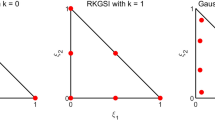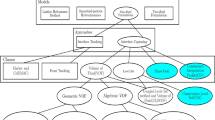Abstract
A new closure-approximated model based on the Cohen/Padé (CP) spring law is presented. Because it is inspired by the finitely extensible non-linear elastic Peterlin version (FENE-P), the model is titled CP-P. The rheological behaviors in simple and pressure-driven pipe shear flows in both the steady-state and time-dependent conditions are compared between the two models. To this end, a new approach based on the second moment Fokker–Planck equation instead of the Langevin equation is developed, which was confirmed by means of the existing analytical and stochastic data prior to its use. Application of this new approach is restricted to the closure approximated models but at a much less computational expense than the CONNFFESSIT-like simulations. In addition, the Brownian configuration field method is employed to make verification possible and more importantly, to shed light on the rheological performance of the CP model. According to the results, the CP-P model behaves similarly to the FENE-P model for the shear flows. The transient rheological behavior of the CP model is significantly different from that of the CP-P model, but both are the same in steady state.











Similar content being viewed by others
References
Abedijaberi A, Khomami B (2011) Continuum and multi-scale simulation of mixed kinematics polymeric flows with stagnation points: closure approximation and the high Weissenberg number problem. J Nonnewtonian Fluid Mech 166:533–545
Alexander M, Spagnolie SE (2015) Introduction to complex fluids. In: Spagnolie SE (ed) Complex fluids in biological systems. Springer, New York, pp. 3–52
Binetruy C, Chinesta F, Keunings R (2015) Multi-scale modeling and simulation of polymer flows in polymers, reinforced polymers and composites. Springer, pp 1–42
Bird R, Dotson P, Johnson N (1980) Polymer solution rheology based on a finitely extensible bead—spring chain model. J Nonnewtonian Fluid Mech 7:213–235
Bird RB, Curtiss C, Armstrong R, Hassager O (1987) Dynamics of polymer liquids Vol. 2 Kinetic Theory, 2nd edn. Wiley, New York
Bonvin J, Picasso M (1999) Variance reduction methods for CONNFFESSIT-like simulations. J Nonnewtonian Fluid Mech 84:191–215
Chauvière C, Lozinski A (2004) Simulation of dilute polymer solutions using a Fokker–Planck equation. Comput fluids 33:687–696
Chinesta F, Keunings R, Leygue A (2013) The proper generalized decomposition for advanced numerical simulations: a primer. Springer Science & Business Media
Christainsen RL, Bird RB (1977) Dilute solution rheology: experimental results and finitely extensible nonlinear elastic dumbbell theory. J Nonnewtonian Fluid Mech 3:161–177
Cohen A (1991) A Padé approximant to the inverse Langevin function. Rheol Acta 30:270–273
Dealy JM, Larson RG (2006) Structure and rheology of molten polymers. Hanser, Munich
Du Q, Liu C, Yu P (2005) FENE dumbbell model and its several linear and nonlinear closure approximations. Multiscale Model Simul 4:709–731
Hayat T, Siddiqui A, Asghar S (2001) Some simple flows of an Oldroyd-B fluid. Int J Engrg Sci 39:135–147
Herrchen M, Öttinger HC (1997) A detailed comparison of various FENE dumbbell models. J Nonnewtonian Fluid Mech 68:17–42
Hulsen M, Van Heel A, Van Den Brule B (1997) Simulation of viscoelastic flows using Brownian configuration fields. J Nonnewtonian Fluid Mech 70:79–101
Hyon Y, Du Q, Liu C (2008) An enhanced macroscopic closure approximation to the micro-macro FENE model for polymeric materials. Multiscale Model Simul 7:978–1002
Jourdain B, Le Bris C, Lelièvre T (2004) On a variance reduction technique for micro–macro simulations of polymeric fluids. J Nonnewtonian Fluid Mech 122:91–106
Keunings R (1997) On the Peterlin approximation for finitely extensible dumbbells. J Nonnewtonian Fluid Mech 68:85–100
Kröger M (2004) Simple models for complex nonequilibrium fluids. Phys Rep 390:453–551
Kröger M (2015) Simple, admissible, and accurate approximants of the inverse Langevin and Brillouin functions, relevant for strong polymer deformations and flows. J Nonnewtonian Fluid Mech 223:77–87
Larson RG (2004) The rheology of dilute solutions of flexible polymers: progress and problems. J Rheol 49:1–70
Laso M, Öttinger H (1993) Calculation of viscoelastic flow using molecular models: the CONNFFESSIT approach. J Nonnewtonian Fluid Mech 47:1–20
Letelier M, Céspedes J (1988) Laminar unsteady flow of elementary non-Newtonian fluids in long pipes. In: Cheremisinoff NP (ed) Encyclopedia of fluid mechanics, vol 7. Gulf Publishing Company, Houston, pp. 55–87
Lielens G, Halin P, Jaumain I, Keunings R, Legat V (1998) New closure approximations for the kinetic theory of finitely extensible dumbbells. J Nonnewtonian Fluid Mech 76:249–279
Lielens G, Keunings R, Legat V (1999) The FENE-L and FENE-LS closure approximations to the kinetic theory of finitely extensible dumbbells. J Nonnewtonian Fluid Mech 87:179–196
Lin Y-H (2011) Polymer viscoelasticity: basics, molecular theories, experiments, and simulations, 2nd edn. World Scientific
Mangoubi C, Hulsen MA, Kupferman R (2009) Numerical stability of the method of Brownian configuration fields. J Nonnewtonian Fluid Mech 157:188–196
Mochimaru Y (1983) Unsteady-state development of plane Couette flow for viscoelastic fluids. J Nonnewtonian Fluid Mech 12:135–152
Oliveira P (2002) An exact solution for tube and slit flow of a FENE-P fluid. Acta Mech 158:157–167
Öttinger HC (1996) Stochastic processes in polymeric fluids: tools and examples for developing simulation algorithms. Springer, Berlin
Öttinger HC (2009) On the stupendous beauty of closure. J Rheol 53:1285–1304
Öttinger H, Van Den Brule B, Hulsen M (1997) Brownian configuration fields and variance reduced CONNFFESSIT. J Nonnewtonian Fluid Mech 70:255–261
Sheikh A, Sharif F (2011) Parametric study of FENE and FENE-P models in steady and unsteady flow in a circular pipe using CONNFFESSIT approach. J Nonnewtonian Fluid Mech 166:1012–1023
Singh S, Subramanian G, Ansumali S (2013) Lattice fokker planck for dilute polymer dynamics. Phys Rev E 88:013301
Treloar LRG (1975) The physics of rubber elasticity. Oxford University Press, USA
Van Heel A, Hulsen M, Van den Brule B (1998) On the selection of parameters in the FENE-P model. J Nonnewtonian Fluid Mech 75:253–271
Warner HR Jr (1972) Kinetic theory and rheology of dilute suspensions of finitely extendible dumbbells. Ind Eng Chem Fund 11:379–387
Waters N, King MM (1970) Unsteady flow of an elastico-viscous liquid. Rheol Acta 9:345–355
Waters N, King M (1971) The unsteady flow of an elastico-viscous liquid in a straight pipe of circular cross section. J Phys D 4:204
Wedgewood LE, Ostrov DN, Bird RB (1991) A finitely extensible bead-spring chain model for dilute polymer solutions. J Nonnewtonian Fluid Mech 40:119–139
Zhou Q, Akhavan R (2003) A comparison of FENE and FENE-P dumbbell and chain models in turbulent flow. J Nonnewtonian Fluid Mech 109:115–155
Acknowledgments
This paper is dedicated to my students, to whom teaching Polymer Dynamics gave me a chance to improve my own understanding. Without the aid of my colleagues, especially Dr. M.H.N. Famili and Dr. N.G. Ebrahimi, this work could not have been accomplished. I also sincerely appreciate the endless support of my lovely parents and unlimited help from my friends, Dr. B. Farshchian and Dr. H. Bahmanpour.
Author information
Authors and Affiliations
Corresponding author
Appendices
Appendix 1
According to Table 1, for the Hookean dumbbells h(σ*, b) = 1 which in combination with Eq. 14 simply compiles to
The initial conformation tensor of FENE-P and CP-P can be obtained similarly, but it needs more complex calculations,
FENE-P
CP-P
Appendix 2
Applying Eq. 14 in matrix form when the fluid reaches steady state in the Couette flow yields
This provides nine equations as follow:
Rights and permissions
About this article
Cite this article
Sheikh, A. A new closure approximation based on the Cohen/Padé spring law and a novel method for its implementation. Rheol Acta 56, 135–148 (2017). https://doi.org/10.1007/s00397-016-0973-0
Received:
Revised:
Accepted:
Published:
Issue Date:
DOI: https://doi.org/10.1007/s00397-016-0973-0




